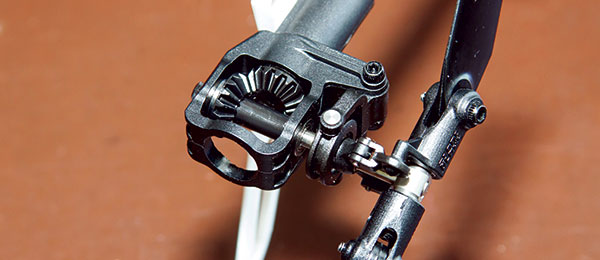
Written by Chris Mulcahy Helicopters Column As seen in the Winter 2014 issue of Park Pilot.
Year-end maintenance is something you shouldn’t ignore. As I sit here, thinking about the content for this article, fall is already threatening to break into winter. For a lot of us, that means having fewer days that we can go out and fly. This is always a great time to submit our helicopters to a little annual maintenance. Our machines are always talking to us, letting us know if things are running smoothly, and we are often given signs if something is not quite right. However, there are also plenty of things that don’t give us any warning. Often, the only way to prevent some type of failure is to preemptively look for it. A regular teardown can truly benefit you. I like to start with the main rotor head. I’ll pull the blade-grip bearings and make sure that all the bearings are still smooth, and that the thrust bearings, if applicable, are greased. Next up is the main gear. I like to check that the one-way bearing is still smooth and greased. I also check for any signs of stress. For belt-driven tails, I’ll check the belt for fraying along the edges, and any other signs of excessive wear. I’ll also check the tension of the belt. For torque-tube tails, I’ll check all of the bearings, also looking for any signs of wear. At the tail end, I’ll disassemble the tailblade grips and check to be sure that the bearings, again if applicable, are smooth, always on the lookout for any signs of unusual wear. I’ll make sure that there are no ball links that feel more worn than the others, replacing any if necessary. For the electronics, I’ll trace all of the wires and look for signs of chafing. I have often found problem areas that could have caused a lot of trouble later on.

This shows the opposite end of the spectrum: parallel charging several small packs.
The key is to check the helicopter from nose to tail: check all bearings, look for wear, look for cracks in the plastic parts, and regrease anything that requires it. Check all the mechanical parts, including the pushrods, bellcranks and servo horns. This is a great time to recheck your general setup, and make those tweaks you held off on in favor of flying. Smart maintainance doesn’t take much time, but you’ll be glad that your helicopters are ready to go when spring rolls around. One of the first things that someone will often think about when buying a new helicopter is how long the battery will last, and how many extra packs should be purchased. Sub-450 class helicopters typically come with a wall charger, and we end up in a waiting game while charging our batteries one pack at a time. Many of us already have aftermarket chargers, and these chargers can be to used to parallel charge our battery packs. Parallel charging lets us charge multiple packs from the same charging port at the same time. To do this, you will need any aftermarket battery charger that lets you select your charge rate and cell count, and a parallel-charging board that matches your specific type of batteries.

Chris carefully checks his machines’ head bearings for wear, applying grease as necessary.
If you are using single-cell batteries, you simply plug them all into the charging board and the charger will view them all as a single cell. All of the cells on the board will balance out as the charger brings the voltage up to a full charge. With multiple-cell packs, the charger will view each series of cells as a single cell. All of the number 1 cells in the packs will be viewed as a single cell, and all the number 2 cells will be viewed as a single cell, and so on throughout the pack. Use the charge rate you would normally select to charge a single pack, then multiply it by the number of packs you are parallel charging. For example, if you want to parallel charge four 250mAh twocell packs, each pack would normally be charged at 2.5 amps for a 1C charge rate. To parallel charge four packs at the same time, multiply 2.5 amps by four to get 10 amps — the rate for a 1C charge on four packs. If you want to charge at 2C, just double it, and so on.

Meticulous maintainance is important. Here, Chris greases his helicopter’s head dampers.
Parallel charging is a great way to get multiple packs charged quickly, and the less time spent charging is more time for flying. I parallel charge everything from small 200mAh single-cell batteries to the six-cell 5000mAh packs used in my 700 sized machines. After a weekend of flying, I do a 1C storage charge on each of my packs individually, so they are ready for the next time I head out to the flying field. -Chris Mulcahy
Article:





